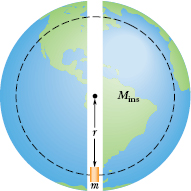Newton’s shell theorem can also be applied to a situation in which a particle is located inside a uniform shell, to show the following:
![]() A uniform shell of matter exerts no net gravitational force on a particle located inside it.
A uniform shell of matter exerts no net gravitational force on a particle located inside it.
Caution: This statement does not mean that the gravitational forces on the particle from the various elements of the shell magically disappear. Rather, it means that the sum of the force vectors on the particle from all the elements is zero.
If Earth’s mass were uniformly distributed, the gravitational force acting on a particle would be a maximum at Earth’s surface and would decrease as the particle moved outward, away from the planet. If the particle were to move inward, perhaps down a deep mine shaft, the gravitational force would change for two reasons. (1) It would tend to increase because the particle would be moving closer to the center of Earth. (2) It would tend to decrease because the thickening shell of material lying outside the particle’s radial position would not exert any net force on the particle.
For a uniform Earth, the second influence would prevail and the force on the particle would steadily decrease to zero as the particle approached the center of Earth. However, for the real (nonuniform) Earth, the force on the particle actually increases as the particle begins to descend. The force reaches a maximum at a certain depth and then decreases as the particle descends farther.
In Pole to Pole, an early science fiction story by George Griffith, three explorers attempt to travel by capsule through a naturally formed (and, of course, fictional) tunnel directly from the south pole to the north pole (Fig. 13-8). According to the story, as the capsule approaches Earth’s center, the gravitational force on the explorers becomes alarmingly large and then, exactly at the center, it suddenly but only momentarily disappears. Then the capsule travels through the second half of the tunnel, to the north pole.
Check Griffith’s description by finding the gravitational force on the capsule of mass m when it reaches a distance r from Earth’s center. Assume that Earth is a sphere of uniform density ρ (mass per unit volume).
Solution: Newton’s shell theorem gives us three Key Ideas here:
1. When the capsule is at radius r from Earth’s center, the portion of Earth that lies outside a sphere of radius r does not produce a net gravitational force on the capsule.
2. The portion of Earth that lies inside that sphere does produce a net gravitational force on the capsule.
3. We can treat the mass Mins of that inside portion of Earth as being the mass of a particle located at Earth’s center.

Fig. 13-8 A capsule of mass m falls from rest through a tunnel that connects Earth’s south and north poles. When the capsule is at distance r from Earth’s center, the portion of Earth’s mass that is contained in a sphere of that radius is Mins.
All three ideas tell us that we can write Eq. 13-1, for the magnitude of the gravitational force on the capsule, as

To write the mass Mins in terms of the radius r, we note that the volume Vins containing this mass is ![]() πr3. Also, because we’re assuming an Earth of uniform desnity, the density ρins = Mins/Vins is Earth’s density ρ. Thus, we have
πr3. Also, because we’re assuming an Earth of uniform desnity, the density ρins = Mins/Vins is Earth’s density ρ. Thus, we have

Then, after substituting this expression into Eq. 13-17 and canceling, we have

This equation tells us that the force magnitude F depends linearly on the capsule’s distance r from Earth’s center. Thus, as r decreases, F also decreases (opposite of Griffith’s description), until it is zero at Earth’s center. At least Griffith got the zero-at-the-center detail correct.
Equation 13-19 can also be written in terms of the force vector ![]() and the capsule’s position vector
and the capsule’s position vector ![]() along a radial axis extending from Earth’s center. Let K represent the collection of constants 4πGmρ/3. Then, Eq. 13-19 becomes
along a radial axis extending from Earth’s center. Let K represent the collection of constants 4πGmρ/3. Then, Eq. 13-19 becomes

in which we have inserted a minus sign to indicate that ![]() and
and ![]() have opposite directions. Equation 13-20 has the form of Hooke’s law (Eq. 7-20,
have opposite directions. Equation 13-20 has the form of Hooke’s law (Eq. 7-20, ![]() = −k
= −k![]() ). Thus, under the idealized conditions of the story, the capsule would oscillate like a block on a spring, with the center of the oscillation at Earth’s center. After the capsule had fallen from the south pole to Earth’s center, it would travel from the center to the north pole (as Griffith said) and then back again, repeating the cycle forever.
). Thus, under the idealized conditions of the story, the capsule would oscillate like a block on a spring, with the center of the oscillation at Earth’s center. After the capsule had fallen from the south pole to Earth’s center, it would travel from the center to the north pole (as Griffith said) and then back again, repeating the cycle forever.
Leave a Reply